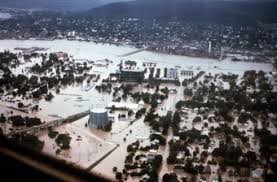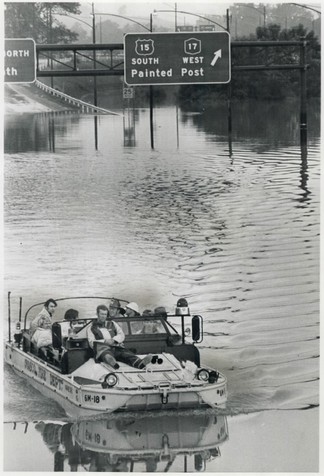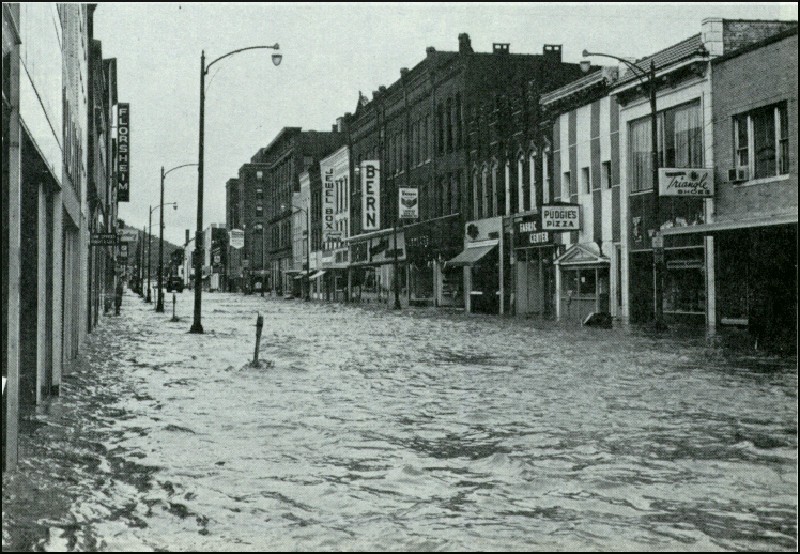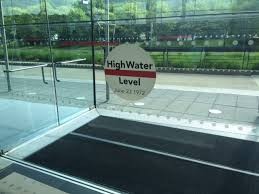The Corning Flood of 1972
Introduction
Text-to-speech Audio
Images
The Current Chemung River

Aerial View of Corning the Morning After the Flood Hit

Rescue Teams Boating Through the Streets of Corning, Heading Towards Painted Post

The Gaffer Districts Market Street Flooded

Sticker on the Wall in the Current Corning Museum of Glass Depicting Highest Water Level During the Flood

Backstory and Context
Text-to-speech Audio
In 1970, Corning, New York was a small town in Upstate New York that was home to nearly 17,000 residents. The town was flourishing. In the center of it all stood Corning Incorporated, the towns largest revenue. In 1970, Corning Inc. created and patented innovative technologies that are still used today. In 1970, they released the first low-loss optical fiber and high-performance cellular ceramic substrate, that is now used in most vehicles world wide. Corning Inc. was the focal point of Corning’s Gaffer District, which was a long street full of local markets, pizzeria’s and mom and pop shops that brought the town close together.
Hurricane Agnes was the source of all the rain that had fallen into the Chemung River days prior to the flood. The hurricane began in Florida as a tropical storm which later parted with land and drifted out towards the Atlantic. As people were under the impression Agnes would die off at sea, the tropical depression regained power and met land over Staten Island. The storm had traveled westward, making its most powerful appearance in Wilkes-Barre, Pennsylvania and Corning, New York where it stalled for days.
On June 23, 1972 the people of Corning were woken around 4:30 or 5:00am by the sound of emergency sirens. The Chemung River that divides Corning down the middle had reached maximum water levels and soon gave way, rushing thousands of gallons of rainwater into the streets. It rained for three to four days without any end in sight thanks to hurricane Agnes. Suddenly, the town of Corning was anywhere from three to six feet underwater.
The next day on June 24, 1972 the water line decreased and left behind impeccable damage that the residents of Corning would have to address in the coming days. As the days continued, the death toll reached 21. Inches of thick slime and mud coated the streets and inches of water remained in people’s homes. Reconstruction of the city began shortly after a majority of the rain water drained. Corning was suffering nearly 230 million dollars worth of property damage. In light of the irreversible damage, the city and its residents were avid about not letting the flood tear down their fighting spirit. Both men, women, and even children took to the streets and neighborhoods to clean up as much as they could. One man states “It took me 15 years to forget. But it’s always there somewhere – that mud, that horrible mud,” explaining how devastating the result of the flood really were.
All homes that were within a mile radius required the most intervention. Homes were destroyed and began rotting from the foundation upwards. Due to the enormous amounts of rainfall that led to the flood, homes were left with inches of mud that covered personal belongings and the basement and ground floors of many. Most homes in this mile radius required help from the city in order to pump out the rest of the water and remove the mud coating. Corning Incorporated funded this town wide clean up without hesitation.
Additionally, the Corning Museum of Glass was severely damaged by the Flood of 72'. Thousands of glass pieces that came from Ancient Roman collections had been shattered. As if the loss of these irreplaceable pieces was not devastating enough, the museums entire library was submerged in flood water. Once the water drained, the museum staff began salvaging as many books, articles, and periodicals they could. Many of the precious and rare collections were not only drenched, but covered in an inch of thick mud. These collections were picked up, boxed up, and sunk to the bottom of neighborhood pools in efforts to remove the mud. After most of the mud had dissolved, museum stuff carefully separated these pieces and left them to dry in backyards around Corning. After the collections were dried, they were carefully packed into boxes as they were suddenly extremely fragile and packed away in the museums library.
Corning and its residents worked from sun up to sun down in order to put their town back on its feet. Corning Inc. supported all efforts financially and made reconstruction possible. Although completely rebuilding and reshaping the town after the flood took nearly three years to complete, Corning residents never gave up on this small town. Now, Corning stands tall, winning "Most Fun Small Town in America" in 2013. At the center of it all stands the Chemung River, now contained by dykes that stand nearly 40 feet tall. In some downtown homes and all over the Corning Museum of Glass there are plagues and stickers on the walls showing where the water line rose after the flood of 72' that serve as small reminders to the community and its visitors exactly where this small town and its spirit has come from.
Cite This Entry
H. Kimble. "The Corning Flood of 1972." Clio: Your Guide to History. December 4, 2019. Accessed April 3, 2025. https://theclio.com/entry/87917
Sources
Bright Enlightenment. “Tropical Storm Agnes Destroys Corning, New York in 1972.” February 14, 2013. YouTube Video, 10:27. https://www.youtube.com/watch?v=5P6TPTl4yBs.
Corning Incorporated. “Business Segments.” Corning Inc. 1994-2019.
Corning Museum of Glass. “The Flood of ’72: Community, Collections, and Conservation.” May 24, 2012. https://www.cmog.org/collection/exhibitions/flood-72-community-collections -and-conservation.
House, Kirk. “Hurricane Agnes: Reality Was Bad Enough.” The Leader, June 24, 2019. https://www.the-leader.com/blogs/20190624/hurricane-agnes-reality-was-bad-enough.
I Love New York Staff. “Corning Officially Named the “Most Fun” Small Town in America.” I Love New York. October 2013.
Knox, Sanka. "Corning Glass Center, Damaged By Flood, Will Reopen on Aug. 1." New York Times (1923-Current file), July 1972:49. https://search.proquest.com/docview/119551921?accountid=26970.
Reckert, Clare M. “Corning Glass Profit Is Up; Flood Damage Assessed: Corning Glass Cites Rise in Earnings.” New York Times (1923-Current file); June 1972: 55. https://search.proquest.com/docview/119372724?accountid=26970.
Thomas, Clarke. “How 2 Towns Recovered from Flood.” Pittsburgh Post-Gazette (1927-2003), October 4, 1982. https://search.proquest.com/docview/1860012055/E1876EA690040C2PQ/10?accountid= 26970.
Kim Thompson. Accessed December, 2019. https://www.pinterest.com/pin/118219558942072498/
J.H. Martin, Corning Museum of Glass, 1972. https://www.cmog.org/library/aerial-view-corning-northside-during-flood-slide
Dave Norris, 1972. https://www.torontopubliclibrary.ca/search.jsp?Erp=20&N=38537&No=160&Ns=p_pub_date_sort&Nso=1&Ntk=Subject_Search_Interface&Ntt=Floods&searchPageType=vrl&view=grid
The National Weather Service. Accessed December, 2019. https://www.weather.gov/images/bgm/flood/june1972/corning001.jpg
Paul E. Fallon. Personal Blog: The Awkward Pose. May 15th, 2015. https://theawkwardpose.com/2015/05/23/trip-log-day-17-corning-ny-to-elmira-ny/

